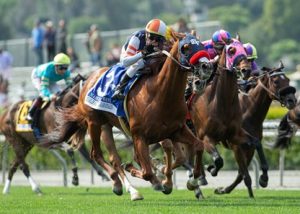CARMA Retirement Resources: Create an Aftercare Plan for Your Racehorse
A racehorse’s average life span is 23-25 years old, while their racing career lasts an average of 1-5 years. Once their racing career is complete, thoroughbreds are often retrained for second careers as hunters, jumpers, or polo horses, while others go on to become family pets or therapy horses.
You can ensure your horse receives the necessary care, support, and resources to live a fulfilling life after their racing career ends by creating an aftercare plan. Aftercare is a crucial part of racehorse ownership that shows your commitment to your horse’s well-being both on and off the track.
Your aftercare plan should contain at least four things:
- When you will retire your horse
- Where you will retire your horse
- Savings to cover the cost of placement
- Records of your horse’s medical history
When to retire your racehorse?
Deciding when to retire a racehorse is a complex decision that takes into account several factors. One key consideration is the horse’s physical health, as injuries or chronic conditions may make it unsafe or uncomfortable for the horse to continue racing. Additionally, the horse’s age and performance history are important factors to consider, as declining performance over time may indicate that the horse is no longer suited for racing. Ultimately, the decision to retire a racehorse should prioritize the well-being and quality of life of the horse.
It is always best to consult with both your veterinarian and trainer to decide when to retire your horse.
Where to retire your racehorse?
- There are many aftercare charities and organizations that can help you retire your racehorse. You can also choose to place your horse through an independent party. It is important that you have written documentation of the transfer of ownership to your chosen party. This can be a bill of sale, contract, or relinquishment form that both parties sign and date.
- Make sure that the organization you place your horse with has a good reputation and is well-funded to be able to take care of your horse. We recommend working with TAA-accredited organizations, CARMA Aftercare Charity partners, or those with official 501c3 designations in good standing.
- Note: Many organizations are at capacity, so you may need to get on a waitlist. Plan to get in touch with them in advance of retiring your horse to secure a space.
What does it cost?
- It is standard to donate a minimum amount of $500-1000 for the intake of a sound horse to provide for the first month of care
- If you are retiring a racehorse with an injury, this can come with a lot of additional costs:
- Surgery/Vet Care
- Rehabilitation time and special services (hand-walking, etc.)
- Please consider donating for the cost of surgery and a few months of rehabilitation
- Create retirement savings for each horse (when they win, this is a great time to stack cash for this!)
- Don’t forget to factor in the cost of transport to your chosen aftercare location
Provide Medical History and Vet Records
- The aftercare organization that takes your horse will be most successful if you give them a thorough medical history and any vet records you possess. This helps prevent reinjury and allows them to choose a suitable discipline.
- Many aftercare organizations are charities, and unnecessary revetting adds financial burden to these organizations. You can help offset this by being as thorough as possible and providing any records you have.
Stay connected with your horse after the track!
- Many new OTTB owners love to learn about the history of their horses before they came to them. Let the aftercare organization you place your horse with know if you’d like to be connected with the new owner.
- Many owners also take satisfaction in seeing their horse excel in second careers, some go on to compete in the Thoroughbred Makeover hosted by the Retired Racehorse Project and other competitions of national or global renown.
Take steps to ensure your horse doesn’t end up back on the track
- Read our blog post: Retiring Your Racehorse with Confidence: 3 Steps To Ensure Your Horse Stays Retired
–
While your horse’s racing days are over, there is so much more he or she has to offer! Give your athlete the retirement they deserve by creating your aftercare plan today.
Thank you for being a responsible horse owner and helping us in our mission to make sure aftercare is not an afterthought!
Additional Resources:
American Equine Association of Equine Practitioners – Transitioning the Retired Racehorse
Thoroughbred Aftercare Alliance
The 501(c)(3) nonprofit Thoroughbred Aftercare Alliance accredits, inspects, and awards grants to approved aftercare organizations to retrain, retire, and rehome Thoroughbreds using industry-wide funding.
AQHA – When to Hang It Up And Retire Your Racehorse

